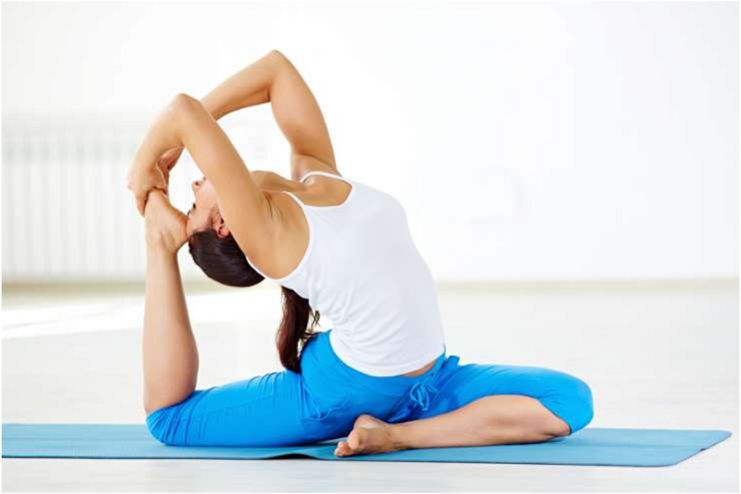AI Contribution
At HealthSpectra, we may use AI to refine grammar and structure, but every piece is shaped, checked, and approved by real people, our expert writers and editors, to ensure clarity, credibility, and care. Learn more..Affiliate Disclaimer
Some links in this article are affiliate links. We may earn a small commission if you make a purchase through these links, at no extra cost to you. We only recommend products we find useful to our readersDaily stretching is essential for overall wellness because it enhances physical function and fosters mindfulness and balance. It promotes a more active lifestyle by keeping the body flexible, decreasing stiffness, increasing mobility, and smoothing out muscular tissue.
Furthermore, stretching improves mental health by encouraging serenity, relaxation, and stress reduction.
Stretching daily encourages psychological and physical well-being and makes life healthier and more energetic. This article explores the numerous advantages of adopting a consistent stretching regimen and illuminates its revolutionary impact on mental and physical health.
Understanding the Importance of Flexibility

Flexibility is often viewed simply as the ability to stretch, but its benefits extend far beyond that. It is defined as the range of motion (ROM) a joint can achieve without causing pain, and it plays a crucial role in overall health. Flexibility directly impacts muscle function, joint mobility, and injury prevention, which are essential for an active and pain-free life.
Maintaining flexibility allows you to move freely and perform daily tasks with ease, while also reducing the risk of falls and injuries. Flexibility exercises are simple to incorporate into your daily routine and are beneficial for people of all ages.
Retaining flexibility keeps your muscles and tendons supple, enabling fluid and efficient movement. This flexibility not only supports muscle recovery and improves posture but also enhances athletic performance.
Benefits of Daily Stretching

Daily stretching is essential for maintaining flexibility and joint mobility. It helps keep muscles long, pliable, and able to function effectively. Without regular stretching, muscles can become stiff and tight, reducing their ability to fully extend and increasing the risk of muscle damage, strains, and joint pain. The benefits of daily stretching include:
- Improved Range of Motion: Regular stretching enhances the ability of your joints to move through their full range of motion, improving mobility and flexibility. Research has shown that stretching can improve both static and dynamic flexibility.
- Enhanced Blood Flow: Stretching increases circulation, which helps to improve blood flow to muscles. This boost in circulation aids in faster recovery, reduces muscle soreness, and supports overall muscle health.
- Reduced Back Pain: Tight muscles can limit your range of motion, putting a strain on your back. Stretching helps to relieve this tension, aiding in the prevention and recovery of back pain.
- Better Posture: Stretching, when combined with strengthening exercises, can address muscle imbalances that contribute to poor posture. Studies show that stretching specific muscle groups can help reduce musculoskeletal pain and promote proper alignment.
- Improved Brain Health: Stretching has been shown to positively affect mood and cognitive function. A study found that practicing yoga and stretching for just ten minutes improved mood, reduced stress, and enhanced cognitive abilities.
Types of Stretches for Improved Flexibility
To achieve your goals of increased flexibility, it’s helpful to know and utilize different types of stretches. We’ll explore three types of stretches: Proprioceptive Neuromuscular Facilitation (PNF), dynamic, and static. Each type has distinct benefits for improving muscle relaxation and flexibility.
Static Stretches: involve holding a specific position for an extended period, typically between 15 and 60 seconds. Static stretches are effective for enhancing flexibility and gradually lengthening muscles. By slowly stretching a muscle and maintaining the position, static stretches increase the range of motion and flexibility. They are often incorporated into comprehensive flexibility programs or used during cool-down exercises.
Dynamic Stretches: consist of controlled, continuous movements that allow muscles and joints to extend fully. Unlike static stretches, dynamic stretches are ideal for warming up before physical activity because they are performed while moving. They improve flexibility by raising body temperature, increasing blood flow, and preparing muscles for more intense exercises. Additionally, dynamic stretching enhances athletic performance and coordination.
Proprioceptive Neuromuscular Facilitation (PNF) Stretches: PNF stretches are advanced techniques that combine muscle contraction and stretching. This method often involves a partner to assist with both the contraction and stretching phases. PNF stretches activate the body’s proprioceptors, sensory receptors that provide information about joint position and muscle tension, facilitating rapid increases in flexibility. By alternating between contraction and relaxation, PNF stretching significantly promotes muscle lengthening, relaxation, and flexibility.
Incorporating a variety of stretches—such as static, dynamic, and PNF—into your routine ensures a comprehensive approach to enhancing flexibility. Each type contributes uniquely to improved muscular flexibility, a broader range of motion, and overall well-being. A diverse stretching regimen can help you maintain flexibility consistently or prepare for exercise, making your body more flexible, resilient, and agile.
How to Incorporate Stretching into Your Daily Routine

Include stretching into your daily routine – a small but significant investment in your general well-being. Below, we provide tips on how to incorporate stretching exercises seamlessly into your daily routine, stressing the value of consistency and slow development to optimize the physical and mental health advantages.
- Start Gradually: If you’re new to stretching or are returning after a break, it’s essential to start slowly. Start with easy stretches that focus on your main muscle groups. Gradually add more complex stretches and techniques to your regimen as your flexibility increases.
- Concentrate on Tense Areas: Note the muscles that feel constrained or tight. The neck, shoulders, hips, and hamstrings are frequently tense. Adjust your stretching regimen to target these trouble spots.
- Make Slow Progress: Avoid jumping into long lengths too soon. As your flexibility increases, progressively increase the duration and intensity. Work your way up to increasingly complex movements by beginning with mild stretches.
- Ideal Length and Frequency: The ideal time for a stretching exercise depends on your schedule and personal objectives. However, you should generally stretch for 15 to 30 minutes daily.
- Take Regular Breaks to Stretch: Make stretching a part of your everyday schedule by taking brief pauses during the day. Get up, extend your arms overhead, and give your neck and shoulders light stretches. These little stretching breaks revitalize your body and counteract the adverse effects of prolonged sitting.
Incorporating stretching into your everyday schedule doesn’t have to be complicated. Your flexibility, mobility, and relaxation will increase with time and dedication.
Stretching and Mental Well-Being
In addition to its many physical advantages, stretching is also a powerful relaxation and stress-reduction technique, which is why it’s essential for mental wellness.
Stress Relief and Relaxation: Stretching is a natural way to relieve tension and promote relaxation from the stresses of daily life. Because muscles tense and contract in reaction to stress, stretching exercises offer a physical release that helps the tension built up in the muscles to release. Stress is reduced, and the mind is calmed due to the matching mental reaction to this physical relaxation. Stretching encourages the parasympathetic nerve system—also known as the “rest and digest” system—to become activated, which leads to a state of equilibrium and relaxation.
Psychological Advantages: Stretching has advantages for the mind that go beyond reducing stress. Frequent stretching has been linked to better mood and increased mental acuity. Stretching makes the body release endorphins, which are naturally occurring mood enhancers. It promotes happiness and well-being. This mood-boosting impact is beneficial in reducing tension or anxiety and fostering emotional resilience.
Mind-Body Connection: One of the main ways that stretching benefits mental health is through the mind-body connection it possesses. The mind is focused on the here and now while the body does different stretches, encouraging mindfulness. Stretching with focused awareness can act as a meditation, enabling people to momentarily tune out outside pressures and concentrate on their own body’s sensations and actions. The outcome is a harmonic fusion of mental and physical health.
Including stretches in your practice, mainly when mindfulness is the focus, promotes mental and physical well-being and flexibility. Stretching as a self-care technique encourages a comprehensive view of well-being by acknowledging the connection between the body and the mind. Making an effort every day puts you on the road to mental clarity, emotional balance, and a more serene outlook on life.
Conclusion
Daily stretching is a strong route to increased flexibility, better posture, and improved general health. Adding stretching to your routine can improve circulation, reduce stress, promote relaxation, and increase your range of motion.
This easy yet effective exercise enhances everyday functioning and prevents injuries by supporting your body’s natural movement patterns. Adopt a regular stretching regimen to enjoy the long-term rewards of increased flexibility, less pain, and an all-around boost in your quality of life.
References
- https://health.ucdavis.edu/sports-medicine/resources/flexibility
- https://ssphysio.com.au/mobility-vs-flexibility/
- https://www.sportsmedtoday.com/flexibility-va-247.htm
- https://www.mayoclinic.org/healthy-lifestyle/fitness/in-depth/stretching/art-20047931
- https://www.medicalnewstoday.com/articles/benefits-of-stretching#benefits
- https://longevity.technology/lifestyle/stretching-exercises-definition-benefits-workout-types-risks/
- https://www.sportsinjuryclinic.net/rehabilitation-exercises/stretching-exercises/types-of-stretching
- https://www.hss.edu/article_static_dynamic_stretching.asp
- https://moyerwellness.com/what-is-pnf-stretching/
- https://www.medicalnewstoday.com/articles/stretching-routine
- https://rxfit.co/why-is-it-important-to-ease-into-an-exercise-program/
- https://www.ncbi.nlm.nih.gov/pmc/articles/PMC3273886/
- https://www.health.harvard.edu/staying-healthy/exercising-to-relax
- https://www.research.colostate.edu/healthyagingcenter/2021/06/23/the-simple-act-of-stretching/
- https://www.nike.com/a/benefits-of-stretching-daily
In this Article


















